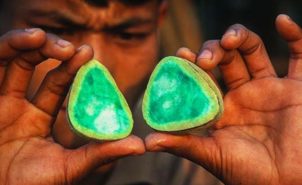
Jade is the diamond of the East. A fast-growing, high-income class in China – who often cherish mystical values associated with jade – are causing a booming demand for jade. In the shadows of this jade-rush, hellish stories emerge from the depths of the jade mines in Myanmar.
Just this year, a landslide caused by the jade mining activity in Myanmar killed 17 people. At least 113 – and maybe as many as 200 – workers died in another accident in 2015.
Working conditions in the mines are so dire that in order to endure the harsh conditions, most miners become heroin addicts. Rivers are polluted and vast swaths of pristine jungle are levelled through illegal land grabs, using intimidation and violence.
Blood jade
Myanmar produces around 70 percent of the world’s jadeite, a variety of jade. Jadeite deposits found in Myanmar’s northern regions are considered to be the highest quality jadeite in the world.
The main production site is located in Kachin state, where an ethnic conflict between the Kachin Independence Army (KIA) and the Myanmar army has been running for decades. A brutal war is paid for by both sides almost entirely through glamorous jade.
According to a damning Global Witness report released by in 2015, the jade industry is mostly controlled by “[old junta] military elite, US-sanctioned drug lords and crony companies” while “very few revenues reach the people of Kachin State […] or the population of Myanmar as a whole”.
Global Witness names and shames the families of former dictator Than Shwe and two generals. They also estimate that the value of the industry was about USD 31 billion in 2014, or nearly half of Myanmar’s official GDP.
The largest importer is China. Global Witness asks: is this the biggest natural resources heist in modern history?
Did the report have any impact on the ground? Maybe it had. In 2016, the government announced a suspension of the mining until a new law on gemstones is passed. In 2017, a draft was published. But people in Kachin state say it still doesn’t take local interests into account.
The bigger picture
Arnim Scheidel, an ecological economist from the Institute of Environmental Science and Technology at the Autonomous University of Barcelona, has been studying social and environmental conflicts in Myanmar as part of a European research project that studies and contributes to the global environmental justice movement.
He says that the conflict for jade is a big one, but at the same time only one of many struggles for environmental justice in Myanmar:
Mining, agribusiness, logging and so forth finances the interests of Myanmar’s powerful elites. Pressure on the country’s resources increased with the recent opening to foreign investment. Locals tend to lose access to land and to a healthy environment to live in. Civil society argues that aggressive resource extraction in historic conflict zones threatens ceasefire agreements and the country’s fragile peace. They demand to return resource control to local groups and call for a moratorium on large-scale extraction projects until the country achieves stability.
The almost exclusive availability of valuable stones in the middle of a minority ethnic area in a not that democratic country seems to be a very potent mix for violent conflict.
According to Global Witness, jade is the main source of income for the Kachin Independence Organization – aside from being almost half of Myanmar’s economy.
After 17 years of ceasefire, fighting re-erupted in June 2011, displacing an estimated 90,000 people by September 2012 and killing hundreds.
From artisanal to industrial mining
Until not so long ago, finding jade was a relatively low impact artisanal mining activity. Looking for surface coloration, checking the sound by tapping with metal tools and feeling subtle rock differences while rocks are submerged in water were common methods to find jade.
Now, the Myanmar Gems Enterprise simply uses heavy machinery to cut through big boulders to reveal pockets of jade. The heavy-handed approach has taken over, both towards the stones and towards the communities who happen to live in the area where jade is found.
The story of jade from the mines of Myanmar is one of fulfilling the fantasies of rich consumers who don’t care about human rights or the environment.
It is also an example of how an officially communist state, China, is now making the same “consumer-is-king” mistake that has been cherished and created since capitalism took root in the West.
But whether the consumer comes from China, The West or elsewhere: the slogan that the consumer is not king is in urgent need of a graphic warning message that the consumer also kills.
This article was first published at The Ecologist

The project ENVJUSTICE has received funding from the European Research Council (ERC) under the European Union’s Horizon 2020 research and innovation programme (grant agreement No. 695446)